Reading time for children: 9 min
A widow had two daughters. One was pretty and industrious, the other was ugly and lazy. And as the ugly one was her own daughter, she loved her much the best, and the pretty one was made to do all the work, and be the drudge of the house. Every day the poor girl had to sit by a well on the high road and spin until her fingers bled.
Now it happened once that as the spindle was bloody, she dipped it into the well to wash it; but it slipped out of her hand and fell in. Then she began to cry, and ran to her step-mother, and told her of her misfortune; and her stepmother scolded her without mercy, and said in her rage: „As you have let the spindle fall in, you must go and fetch it out again!“ Then the girl went back again to the well, not knowing what to do, and in the despair of her heart she jumped down into the well the same way the spindle had gone.
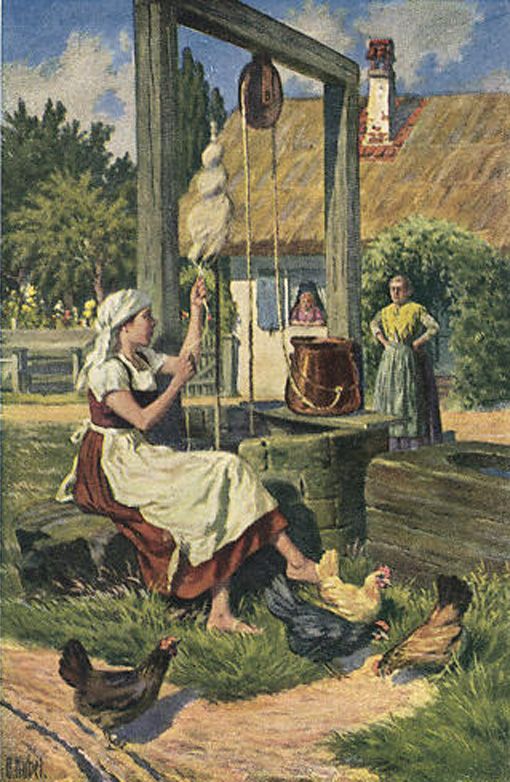 Image: Otto Kubel (1868 – 1951)
Image: Otto Kubel (1868 – 1951)After that she knew nothing; and when she came to herself she was in a beautiful meadow, and the sun was shining on the flowers that grew round her. And she walked on through the meadow until she came to a baker’s oven that was full of bread; and the bread called out to her: „Oh, take me out, take me out, or I shall burn. I am baked enough already!“
Then she drew near, and with the baker’s peel she took out all the loaves one after the other. And she went farther on till she came to a tree weighed down with apples, and it called out to her: „Oh, shake me, shake me, we apples are all of us ripe!“ Then she shook the tree until the apples fell like rain, and she shook until there were no more to fall; and when she had gathered them together in a heap, she went on farther.
At last she came to a little house, and an old woman was peeping out of it, but she had such great teeth that the girl was terrified and about to run away, only the old woman called her back. „What are you afraid of, my dear child? Come and live with me, and if you do the house-work well and orderly, things shall go well with you. You must take great pains to make my bed well, and shake it up thoroughly, so that the feathers fly about, and then in the world it snows, for I am Mother Hulda.“
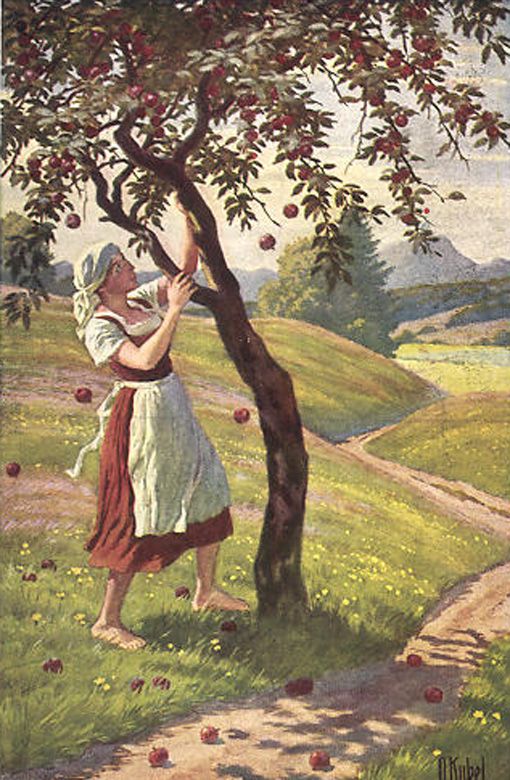 Image: Otto Kubel (1868 – 1951)
Image: Otto Kubel (1868 – 1951)As the old woman spoke so kindly, the girl took courage, consented, and went to her work. She did everything to the old woman’s satisfaction, and shook the bed with such a will that the feathers flew about like snow-flakes: and so she led a good life, had never a cross word, but boiled and roast meat every day.
When she had lived a long time with Mother Hulda, she began to feel sad, not knowing herself what ailed her; at last she began to think she must be home-sick; and although she was a thousand times better off than at home where she was, yet she had a great longing to go home. At last she said to her mistress: „I am homesick, and although I am very well off here, I cannot stay any longer. I must go back to my own home.“
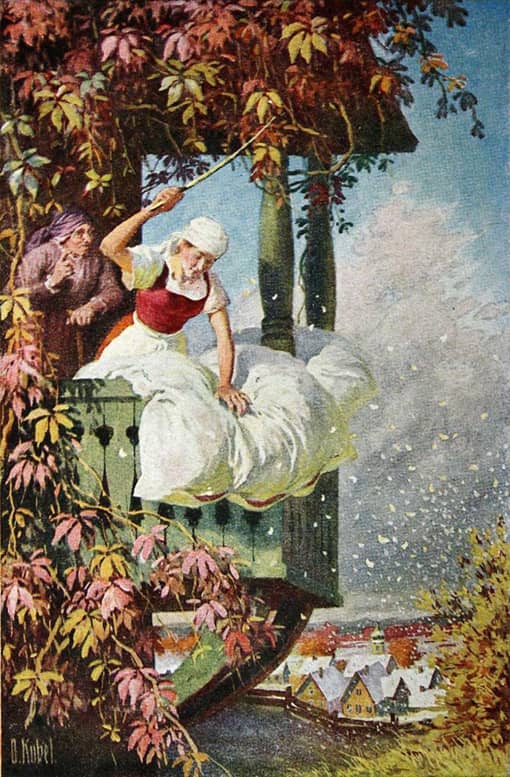 Image: Otto Kubel (1868 – 1951)
Image: Otto Kubel (1868 – 1951)Mother Hulda answered: „It pleases me well that you should wish to go home, and, as you have served me faithfully, I will undertake to send you there!“ She took her by the hand and led her to a large door standing open, and as she was passing through it there fell upon her a heavy shower of gold, and the gold hung all about her, so that she was covered with it.
„All this is yours, because you have been so industrious,“ said Mother Hulda; and, besides that, she returned to her her spindle, the very same that she had dropped in the well. And then the door was shut again, and the girl found herself back again in the world, not far from her mother’s house; and as she passed through the yard the cock stood on the top of the well and cried:
„Cock-a-doodle doo! Our golden girl has come home too!“
Then she went in to her mother, and as she had returned covered with gold she was well received.
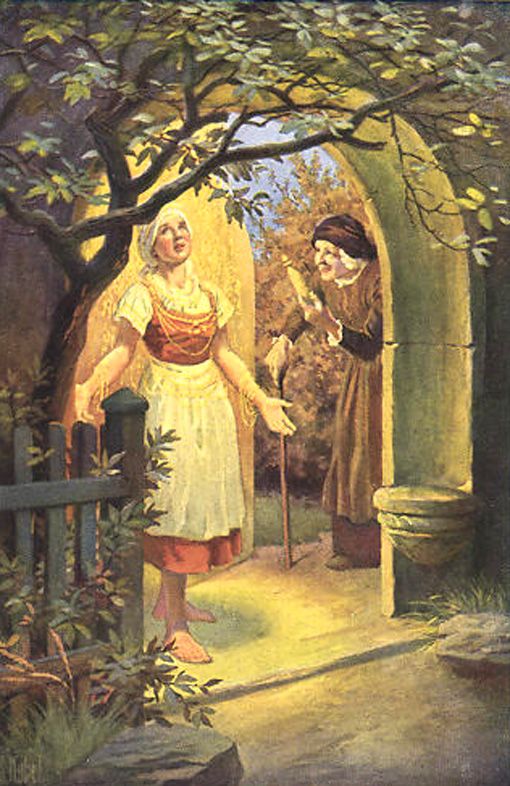 Image: Otto Kubel (1868 – 1951)
Image: Otto Kubel (1868 – 1951)So the girl related all her history, and what had happened to her, and when the mother heard how she came to have such great riches she began to wish that her ugly and idle daughter might have the same good fortune. So she sent her to sit by the well and spin; and in order to make her spindle bloody she put her hand into the thorn hedge.
Then she threw the spindle into the well, and jumped in herself. She found herself, like her sister, in the beautiful meadow, and followed the same path, and when she came to the baker’s oven, the bread cried out: „Oh, take me out, take me out, or I shall burn. I am quite done already!“ But the lazy-bones answered: „I have no desire to black my hands,“ and went on farther.
Soon she came to the apple-tree, who called out: „Oh, shake me, shake me, we apples are all of us ripe!“ But she answered: „That is all very fine; suppose one of you should fall on my head,“ and went on farther. When she came to Mother Hulda’s house she did not feel afraid, as she knew beforehand of her great teeth, and entered into her service at once.
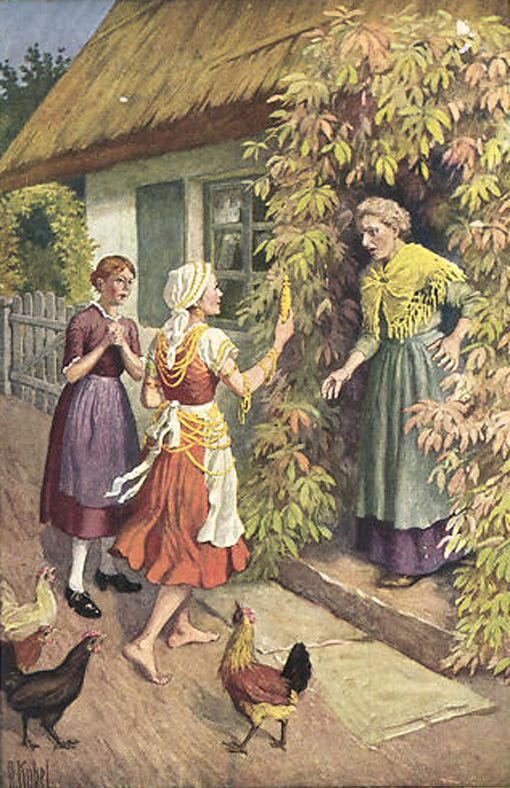 Image: Otto Kubel (1868 – 1951)
Image: Otto Kubel (1868 – 1951)The first day she put her hand well to the work, and was industrious, and did everything Mother Hulda bade her, because of the gold she expected; but the second day she began to be idle, and the third day still more so, so that she would not get up in the morning. Neither did she make Mother Hulda’s bed as it ought to have been made, and did not shake it for the feathers to fly about.
So that Mother Hulda soon grew tired of her, and gave her warning, at which the lazy thing was well pleased, and thought that now the shower of gold was coming. So Mother Hulda led her to the door, and as she stood in the doorway, instead of the shower of gold a great kettle full of pitch was emptied over her. „That is the reward for your service,“ said Mother Hulda, and shut the door. So the lazy girl came home all covered with pitch, and the cock on the top of the well seeing her, cried:
„Cock-a-doodle doo! Our dirty girl has come home too!“
And the pitch remained sticking to her fast, and never, as long as she lived, could it be got off.
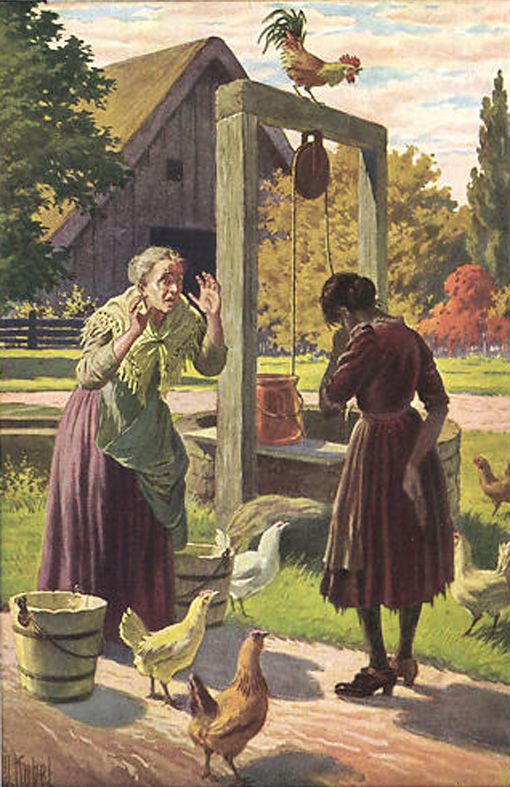 Image: Otto Kubel (1868 – 1951)
Image: Otto Kubel (1868 – 1951) Learn languages. Double-tap on a word.Learn languages in context with Childstories.org and Deepl.com.
Learn languages. Double-tap on a word.Learn languages in context with Childstories.org and Deepl.com.Backgrounds to fairy tale „Mother Hulda“
„Mother Hulda,“ also known as „Frau Holle,“ is a well-known German fairy tale collected by the Brothers Grimm in their 1812 publication „Children’s and Household Tales.“ The tale is rooted in German and European folklore and oral storytelling traditions. Mother Hulda has been associated with pre-Christian Germanic mythology, and some interpretations link her to the ancient Germanic goddess Holda or Holle.
The story revolves around two sisters: one kind and hardworking, while the other is lazy and unkind. The kind sister is mistreated by her stepmother and stepsister, and one day, while drawing water from a well, she accidentally drops her spindle and falls into the well. She finds herself in Mother Hulda’s domain, where she helps the old woman with various chores. Mother Hulda rewards her diligence and kindness by sending her back to the world covered in gold.
When the stepmother sees the reward the kind sister has received, she sends her own lazy daughter to Mother Hulda, hoping for a similar outcome. However, the lazy daughter is unwilling to help Mother Hulda with chores and is rude to her. As a result, when she returns to the world, she is covered in pitch instead of gold. The backgrounds to „Mother Hulda“ reflect both the Brothers Grimm’s efforts to collect and preserve traditional European folktales and the story’s connections to ancient Germanic mythology. The tale explores themes of kindness, hard work, and the consequences of one’s actions, as well as the concept of cosmic justice.
The character Mother Hulda, or Frau Holle, has her roots in Germanic mythology and pre-Christian beliefs. She is considered a wise, supernatural figure with associations to nature, fertility, and the changing seasons. In some traditions, she is believed to be a goddess or a supernatural being who can influence the weather, particularly when it snows. The tale of Mother Hulda combines elements of these ancient beliefs with a moral lesson, creating a story that is both entertaining and educational. Frau Holle, also known as Holda, Perchta, and other regional names, is a legendary female figure in Germanic folklore. She was originally a pre-Christian goddess who survived in popular belief well into the 19th century. Her origins trace back to ancient Germanic and possibly Celtic traditions.
Frau Holle is often associated with spinning, weaving, and overseeing related crafts. She is also connected to the spirit world and witchcraft in some folk traditions. During the winter months, particularly the Twelve Nights of Christmas, she is said to visit homes and punish the lazy while rewarding the virtuous or those who help her. Frau Holle has various regional counterparts such as Frau Gauden, Perchta, and Spillaholle. Each of these figures shares similarities with Frau Holle, but may have unique aspects or stories associated with them. In pre-Christian Alpine traditions, Frau Holle and her counterparts feature in wild masked processions and seasonal festivals.
The story of Mother Hulda has been adapted and retold in various forms over the years, including plays, television programs, and films. The tale remains popular among children and adults alike, as it carries a timeless message of the value of hard work, kindness, and fairness.
Interpretations to fairy tale „Mother Hulda“
„Mother Hulda“ from the Brothers Grimm is a tale rich in themes and potential interpretations. Here are some key interpretations of the story:
The importance of hard work and diligence: The story emphasizes the value of hard work and dedication, as the kind sister is rewarded for her diligent efforts, while the lazy sister is punished for her unwillingness to work. The tale emphasizes the value of being hardworking and diligent, as the industrious stepdaughter is rewarded with gold and a better life. In contrast, the lazy sister faces consequences for her lack of effort and unwillingness to help others.
Kindness and compassion: The story demonstrates the importance of showing kindness and compassion towards others. The pretty stepdaughter helps the baker and the apple tree without expecting anything in return, whereas the lazy sister refuses to help them out of selfishness. As a result, the kind-hearted girl receives the blessings of Mother Hulda and others in the magical land. The kind sister’s compassionate nature is contrasted with the lazy sister’s selfishness, demonstrating the importance of treating others with kindness and empathy.
The consequences of favoritism and mistreatment: The tale highlights the negative effects of favoritism and mistreatment within families. The widow’s preference for her lazy daughter and mistreatment of her stepdaughter backfires when the lazy daughter returns home covered in pitch, while the stepdaughter flourishes in life.
The rewards of perseverance and courage: The industrious stepdaughter faces her fears and takes risks in her pursuit of happiness. Her willingness to jump into the unknown (the well) and confront her challenges leads her to a better life.
The concept of cosmic justice: The tale also explores the idea of cosmic justice, where individuals ultimately receive what they deserve based on their actions. The industrious stepdaughter is rewarded with gold and happiness, while the lazy sister is punished with pitch and shame. This illustrates the belief that good deeds lead to good outcomes, while bad deeds result in negative consequences. „Mother Hulda“ illustrates the idea that one’s actions, whether good or bad, will eventually come back to them in the form of rewards or punishment. The kind sister is rewarded with gold, while the lazy sister is punished with pitch.
The dangers of greed and envy: The stepmother’s greed and envy are highlighted when she sends her own daughter to Mother Hulda, hoping for the same reward as the kind sister. This decision ultimately leads to her daughter’s punishment, illustrating the dangers of allowing these negative emotions to guide one’s actions.
The transformative power of adversity: The kind sister’s hardships and mistreatment shape her into a diligent and compassionate individual. Her experiences ultimately lead to her reward, demonstrating that adversity can sometimes be a catalyst for personal growth and transformation.
Overall, „Mother Hulda“ offers several themes and interpretations, including the importance of hard work, kindness, and the consequences of one’s actions. The story serves as a reminder that one’s actions and character will ultimately determine their fate, and that cosmic justice will reward or punish individuals accordingly. In summary, „Mother Hulda“ is a fairy tale that teaches valuable life lessons about hard work, kindness, compassion, courage, and the importance of treating others fairly. It also reflects on the consequences of one’s actions, emphasizing the belief in cosmic justice.
Adaptions of the fairy tale „Mother Hulda“
„Mother Hulda,“ also known as „Frau Holle“ or „Mother Holle,“ is a German fairy tale collected by the Brothers Grimm, Jacob and Wilhelm Grimm. The tale is part of their famous collection, „Kinder- und Hausmärchen“ (Children’s and Household Tales), first published in 1812. The Brothers Grimm were German academics, philologists, and cultural researchers who collected and published folklore during the 19th century, contributing significantly to the popularization of German and European folktales. „Mother Hulda,“ also known as „Frau Holle,“ has been adapted in various forms across different media, ensuring that the story remains popular and engaging for audiences of all ages. Here are some examples of adaptations of the tale:
Illustrated Books: Numerous illustrated children’s books and collections of Brothers Grimm fairy tales include „Mother Hulda.“ These adaptations often feature engaging illustrations and simplified language to make the story more accessible to younger readers.
Animation: „Mother Hulda“ has been adapted into animated films and TV episodes. For instance, in 1961, a Soviet animated film titled „Frau Holle“ was directed by Valentina Brumberg and Zinaida Brumberg. The story has also been featured in various animated anthology series, such as „Grimm’s Fairy Tale Classics“ and „Simsala Grimm.“ „Snow White and the Huntsman“ (2012): This is a film that is loosely based on „Mother Hulda“ and other fairy tales. The film features Charlize Theron as the evil queen who sends Snow White (Kristen Stewart) to meet Mother Hulda, who is depicted as a wild and unpredictable figure.
Films and TV: The tale has been adapted into live-action films and television episodes. For example, the 1985 East German film „Frau Holle“ by director Wolfgang Hübner and the 2008 German television film „Frau Holle“ directed by Bodo Fürneisen. „Mother Holle“ (1937): This is a German film adaptation of the fairy tale directed by Fritz Genschow. The film was made during the Nazi era and was intended to promote the ideology of „blood and soil“ by depicting the virtues of hard work and rural life. „Mother Hulda“ (1954): This is a Czechoslovakian stop-motion animation film directed by Jiří Trnka. The film is known for its stunning visual style and atmospheric music, and it was nominated for the Palme d’Or at the 1954 Cannes Film Festival. „Mother Hulda“ (1961): This is a Soviet animated film directed by Boris Dyozhkin. The film features a modern retelling of the fairy tale and is known for its colorful animation and catchy songs.
Theater and Musical Productions: „Mother Hulda“ has been brought to life on stage in various theatrical and musical adaptations, including plays, musicals, ballets, and puppet shows. These adaptations often feature original music and innovative interpretations of the source material. „Into the Woods“ (1986): This is a Broadway musical by Stephen Sondheim and James Lapine that features several fairy tales, including „Mother Hulda.“ The musical has been staged numerous times and has been adapted into a film in 2014. „Faerie Tale Theater: Mother Goose“ (1985): This is an American television series that adapted several fairy tales, including „Mother Hulda.“ The episode features Shelley Duvall as Mother Goose and Carol Kane as the wicked step-sister.
Audiobooks and Radio Dramas: Audiobooks and radio dramas featuring „Mother Hulda“ have been produced, offering an auditory experience of the story. These adaptations can be found on platforms like Audible or as part of radio programs dedicated to fairy tales and folklore.
Art: Artists have been inspired by „Mother Hulda“ to create visual art, such as paintings and illustrations, that capture the essence of the story or reimagine its characters and settings.
These various adaptations of „Mother Hulda“ ensure that the story remains relevant and engaging to audiences of all ages, highlighting the tale’s enduring themes and moral lessons.
Summary of the plot
„Mother Hulda,“ also known as „Frau Holle,“ is a fairy tale from the Brothers Grimm that tells the story of two sisters with contrasting personalities. One sister is kind, hardworking, and diligent, while the other is lazy, selfish, and unkind. The kind sister is mistreated by her stepmother and stepsister. One day, while drawing water from a well, the kind sister accidentally drops her spindle and falls into the well. She wakes up in a strange world, where she meets an old woman named Mother Hulda. Mother Hulda asks the kind sister to help her with various chores, and the girl willingly obliges, working diligently.
Impressed by the girl’s hard work and kindness, Mother Hulda rewards her by sending her back to her world covered in gold. The stepmother, seeing the reward, sends her own lazy daughter to Mother Hulda in the hope of receiving the same fortune. However, the lazy daughter refuses to help with the chores and treats Mother Hulda rudely. As a result, when the lazy daughter returns to her world, she is covered in pitch instead of gold. The story concludes with the kind sister being rewarded for her diligence and kindness, while the lazy sister is punished for her selfishness and laziness. The tale emphasizes themes of hard work, compassion, and the consequences of one’s actions.
Abstract
„Mother Hulda,“ a fairy tale by Brothers Grimm, tells the story of a widow with two daughters: one pretty and hardworking, the other ugly and lazy. The widow favors her own lazy daughter, while the hardworking stepdaughter is treated poorly and made to do all the chores.
One day, while spinning near a well, the stepdaughter accidentally drops her spindle into the well. The stepmother, in her rage, orders her to retrieve it. Desperate and afraid, the girl jumps into the well and finds herself in a beautiful meadow. As she explores the meadow, she helps a baker by taking out his bread from the oven and shakes an apple tree to collect ripe apples.
She then comes across a little house where she meets Mother Hulda, a kind old woman with large teeth. Mother Hulda asks the girl to live with her and do household chores. The girl agrees and diligently fulfills her duties. After some time, the girl becomes homesick and asks to return home. Mother Hulda sends her back, showering her with gold and returning her lost spindle.
Upon returning home, the stepdaughter is welcomed by her family. Her envious mother sends her lazy daughter to try the same fortune. The lazy daughter intentionally drops her spindle in the well and jumps in. However, she refuses to help the baker and the apple tree. She ends up working for Mother Hulda but does not perform her duties well. As a result, instead of a shower of gold, she is covered in pitch when she returns home.
In this tale, the pretty and industrious stepdaughter is rewarded for her kindness and hard work, while the ugly and lazy daughter faces the consequences of her selfishness and laziness.
Informations for scientific analysis
Fairy tale statistics | Value |
|---|---|
| Number | KHM 24 |
| Aarne-Thompson-Uther-Index | ATU Typ 480 |
| Translations | DE, EN, EL, DA, ES, FR, PT, FI, HU, IT, JA, NL, PL, RO, RU, TR, VI, ZH |
| Readability Index by Björnsson | 33.7 |
| Flesch-Reading-Ease Index | 78.9 |
| Flesch–Kincaid Grade-Level | 8.5 |
| Gunning Fog Index | 11 |
| Coleman–Liau Index | 6.7 |
| SMOG Index | 7.7 |
| Automated Readability Index | 9.1 |
| Character Count | 5.973 |
| Letter Count | 4.502 |
| Sentence Count | 47 |
| Word Count | 1.179 |
| Average Words per Sentence | 25,09 |
| Words with more than 6 letters | 102 |
| Percentage of long words | 8.7% |
| Number of Syllables | 1.428 |
| Average Syllables per Word | 1,21 |
| Words with three Syllables | 28 |
| Percentage Words with three Syllables | 2.4% |
















